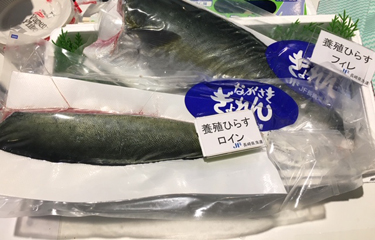Yellowtail – known as “buri” or “hamachi” in Japanese – is Japan’s top farmed finfish export by value at USD 137 million (EUR 122.9 million, JPY 14.7 billion), and as such, is displayed at most seafood shows in Japan.
At the Seafood Show Osaka 2020 in February - one of the last seafood trade shows to take place before the onset of the COVID-19 crisis shut down large public industry gatherings, hamachi and its close relatives in the genus, kampachi and hiramasa, took center stage.
Both buri (Seriola quinqueradiata), as well as kampachi (Seriola dumerili) and hiramasa (Seriola lalandi) were featured by numerous companies farming them in Japan. Typically, hiramasa’s taste and texture are similar to kampachi, and compared with the buttery fatness of farmed buri, both are springier and have a cleaner taste.
The Nagasaki Fisheries Cooperative Association prominently featured hiramasa at the event, the rarest and most expensive of Japan’s three farmed seriola species. The association’s subsection chief, sales section, Daisuke Yamasaki said that hiramasa tracks with kampachi on price, but not with buri, which is cheaper. The price of farmed hiramasa is not strongly affected by wild-catch quantities, as producers can adjust feeding to bring the farmed fish on faster or slower to avoid timing harvests when wild catches are strong, Yamasaki added.
At the show, the association displayed a 1.5-kilogram hiramasa fillet. Yamasaki said that this product runs in the range of JPY 2,500 to JPY 3,500 per kilogram (USD 23.42 to USD 32.78, EUR 20.93 to EUR 29.30). This year prices are at the higher end of the range. The main determinant of price is the farmed production quantity, which in turn is mostly a function of water temperature – the fish fatten faster when the water is warm. Production is mainly in southern Japan, around Kagoshima or Nagasaki, as the species is sensitive to cold.
Based on 2016 data from the 92nd Statistical Yearbook of Ministry of Agriculture, Forestry and Fisheries, the top yellowtail farming prefectures were Kagoshima, with 46,217 metric tons (MT); Ehime, with 22,002 MT; and Oita, with 20,366 MT. Total farmed production of yellowtail in 2018 was approximately 100,000 MT, while volumes for kampachi and hiramasa were 34,000 and just 5,000 MT, respectively.
Misutā Togawa, the section chief in the sales section for the company’s fishery department in the Matsuyama City, Ehime Prefecture office, said that Chubu Shiryo sells 1.7-kilogram yellowtail fillet at roughly JPY 1,500 (USD 14.05, EUR 12.56). He confirmed that customers in the United States prefer a larger fillet than Japan or the E.U.
Also at the show, Kochi Prefecture promoted its red sea bream, buri (yellowtail), kampachi, and bluefin tuna, representing a mix of species that is typical for companies headquartered in areas suitable for yellowtail aquaculture. Producers tend to diversify among the species to reduce risk, such as depressed prices or disease. The prefecture’s Minamimaru Co., Ltd. featured its branded “Tosa Kanpachi Kiwami” greater amberjack and “kaientai Red Sea Bream.”
Dohsui Co. Ltd., a Hakodate, Hokkaido, Japan-based seafood trading company, featured a huge seven-kilogram fillet at the show that the company’s processing warehouse section chief, Kenya Tsuji, confirmed was too big for the Japanese market. The firm was established as a processing facility in Shukumo City, Kochi Prefecture in April 2019 in cooperation with Michisuiya Fisheries.
In addition to fresh products for domestic use, the company also produces frozen processed products for export using proton-freezing and liquid-freezing machines. Its subsidiary, Domizuya Fisheries Co., Ltd., based in Otsuki-cho, Kochi Prefecture, co-exhibited with Dohsui at the show, and displayed its cultivated bluefin tuna and yellowtail from Shukumo Bay, Kochi Prefecture.
Chubu Shiryo Co., Ltd., a feed manufacturer headquartered in Nagoya, displayed yellowtail at Seafood Show Osaka. The company finishes the fish with meat-quality improving feed that contains ingredients such as tea catechin and kelp. Catechins are phenolic compounds abundant in tea, cocoa, and berries, which have strong antioxidant activity. The company advertises its yellowtail as having no fishy smell, and as keeping good color in the blood-saturated portion – a strip of dark meat running along the fish’s body between the lighter back and belly portions.
Special feeds are a popular way for commodity fish farmers in Japan to differentiate their product. The Nobeoka Fisheries Production Center Sales Promotion Council, from Miyazaki Prefecture, promoted “Hebesuburi” at the show. Hebesu is a citrus fruit that is mixed, along with olives, into the feed to supply vitamin C and eight essential amino acids. The company’s branded "Horoi kanpachi" is made with a soft feed containing sake lees.
Photo courtesy of Chris Loew/SeafoodSource







